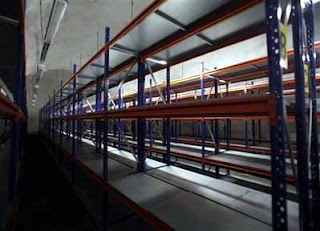A Noah’s Ark of food
 Update: On February 3rd I posted a story on the Svalbard Global Seed Vault -- a repository for the world's crop varieties -- by Brian Walsh that ran in Time Magazine. At the time seeds were being delivered but the vault was not officially operative.
Update: On February 3rd I posted a story on the Svalbard Global Seed Vault -- a repository for the world's crop varieties -- by Brian Walsh that ran in Time Magazine. At the time seeds were being delivered but the vault was not officially operative.Well the vault opened for business this past weekend. Two days ahead of schedule.
Feeling more secure are you? (GW)
Arctic ‘Doomsday Vault’ Filled With World’s Seeds Comes to Life
by Pierre-Henry Deshayes
Agence France Presse
February 24, 2008
An Arctic “doomsday vault” filled with samples of the world’s most important seeds will be inaugurated in Norway today.
The vault aims to provide humankind with a Noah’s Ark of food in the event of a global catastrophe.
European Commission President Jose Manuel Barroso and Nobel Peace Prize winning environmentalist Wangari Matai will be among the personalities present at the inauguration of the vault, which has been carved into the permafrost of a remote Arctic mountain, just 1000km from the North Pole.
The vault, made up of three spacious cold chambers each measuring 27m by 10m, creates a long trident-shaped tunnel bored into the sandstone and limestone.
It has the capacity to hold up to 4.5 million batches of seeds from all known varieties of the planet’s main food crops, making it possible to re-establish plants if they disappear from their natural environment or are obliterated by major disasters.
“The facility is built to hold twice as many varieties of agricultural crops as we think exist,” explained Cary Fowler, executive director of the Global Crop Diversity Trust and project mastermind.
“It will not be filled up in my lifetime, nor in my grandchildren’s lifetime,” he predicted.
Norway has assumed the €6 million ($9.6m) charge for building the vault in its Arctic archipelago of Svalbard, where ironically no crops grow.
Secured behind an airlock door, the three airtight chambers have the capacity to house duplicates of samples from all the world’s more than 1400 existing seed banks.
Many of the more vulnerable seed banks have begun contributing to the “doomsday vault” collection, but some of the world’s biodiversity has already disappeared, with gene vaults in both Iraq and Afghanistan destroyed by war and a seed bank in the Philippines annihilated by a typhoon.
By the time of the inauguration, the Svalbard Global Seed Vault should hold some 250,000 samples, which will remain the property of their countries of origin.
Pakistan and Kenya, both undergoing periods of serious unrest, have sent seed collections, while samples sent from Colombia have been closely scrutinised by police to avoid the project becoming a vehicle for drug trafficking.
“I’ve been working in this field for 30 years and I thought I knew at least all the crops,” Mr Fowler said.
After receiving a list of all the different seeds in the vault, however, “I must admit there are a number of crops I’ve never heard of before”, he said.
That’s a spectacular amount of diversity for Svalbard, where no trees can grow due to the permafrost and where the mercury plummets to an average 14C below zero in winter.
The Norwegian archipelago, which is home to some 2300 people, was selected not despite but because of its inhospitable climate, as well as its remote location far from civil strife.
The seeds of wheat, maize, oats and other crops will be stored at a constant temperature of minus 18C Celsius, and even if the freezer system fails the permafrost will ensure that temperatures never rise above 3.5C below freezing.
“Svalbard really met all the criteria,” Mr Fowler said.
Protected by high walls of fortified concrete, an armoured door, a sensor alarm and the native polar bears that roam the region, the “doomsday vault” has been built 130m above current sea level - high enough that it would not flood if the Greenland and Antarctic ice sheets melt entirely due to global warming.
The concrete cocoon has also been built to withstand nuclear missile attacks or a plunging plane, something that could come in handy in light of the 6.4-scale tremor - the biggest earthquake in Norway’s history - registered near the archipelago on Thursday.

0 Comments:
Post a Comment
<< Home